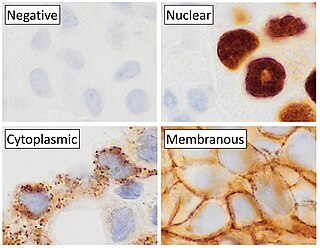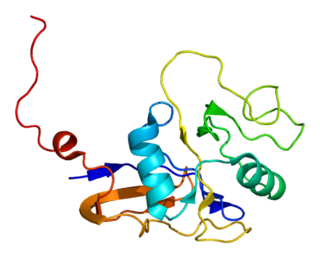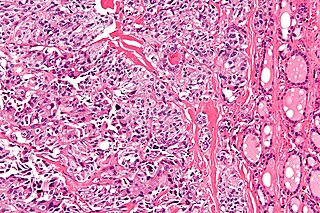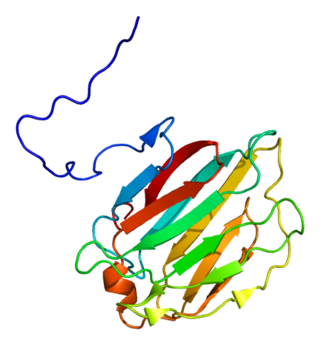
Adenocarcinoma is a type of cancerous tumor that can occur in several parts of the body. It is defined as neoplasia of epithelial tissue that has glandular origin, glandular characteristics, or both. Adenocarcinomas are part of the larger grouping of carcinomas, but are also sometimes called by more precise terms omitting the word, where these exist. Thus invasive ductal carcinoma, the most common form of breast cancer, is adenocarcinoma but does not use the term in its name—however, esophageal adenocarcinoma does to distinguish it from the other common type of esophageal cancer, esophageal squamous cell carcinoma. Several of the most common forms of cancer are adenocarcinomas, and the various sorts of adenocarcinoma vary greatly in all their aspects, so that few useful generalizations can be made about them.

Keratin 20, often abbreviated CK20, is a protein that in humans is encoded by the KRT20 gene.

Immunohistochemistry (IHC) is a form of immunostaining. It involves the process of selectively identifying antigens (proteins) in cells and tissue, by exploiting the principle of antibodies binding specifically to antigens in biological tissues. Albert Hewett Coons, Ernest Berliner, Norman Jones and Hugh J Creech was the first to develop immunofluorescence in 1941. This led to the later development of immunohistochemistry.
A tumor marker is a biomarker that can be used to indicate the presence of cancer or the behavior of cancers. They can be found in bodily fluids or tissue. Markers can help with assessing prognosis, surveilling patients after surgical removal of tumors, and even predicting drug-response and monitor therapy.

The selectins are a family of cell adhesion molecules. All selectins are single-chain transmembrane glycoproteins that share similar properties to C-type lectins due to a related amino terminus and calcium-dependent binding. Selectins bind to sugar moieties and so are considered to be a type of lectin, cell adhesion proteins that bind sugar polymers.

The CD44 antigen is a cell-surface glycoprotein involved in cell–cell interactions, cell adhesion and migration. In humans, the CD44 antigen is encoded by the CD44 gene on chromosome 11. CD44 has been referred to as HCAM, Pgp-1, Hermes antigen, lymphocyte homing receptor, ECM-III, and HUTCH-1.
Tumor M2-PK is a synonym for the dimeric form of the pyruvate kinase isoenzyme type M2 (PKM2), a key enzyme within tumor metabolism. Tumor M2-PK can be elevated in many tumor types, rather than being an organ-specific tumor marker such as PSA. Increased stool (fecal) levels are being investigated as a method of screening for colorectal tumors, and EDTA plasma levels are undergoing testing for possible application in the follow-up of various cancers.
Technetium (99mTc) arcitumomab is a drug used for the diagnostic imaging of colorectal cancers, marketed by Immunomedics. It consists of the Fab' fragment of a monoclonal antibody and a radionuclide, technetium-99m.

Carbohydrate antigen 19-9 (CA19-9), also known as sialyl-LewisA, is a tetrasaccharide which is usually attached to O-glycans on the surface of cells. It is known to play a role in cell-to-cell recognition processes. It is also a tumor marker used primarily in the management of pancreatic cancer.

Mesothelin, also known as MSLN, is a protein that in humans is encoded by the MSLN gene.
Podocalyxin, a sialoglycoprotein, is thought to be the major constituent of the glycocalyx of podocytes in the glomerulus in the kidneys. It is a member of the CD34 family of transmembrane sialomucins. It coats the secondary foot processes of the podocytes. It is negatively charged and thus functions through charge repulsion to keep adjacent foot processes separated, thereby keeping the urinary filtration barrier open. This function is further supported by knockout studies in mice which reveal an essential role in podocyte morphogenesis and a role in the opening of vascular lumens and regulation of vascular permeability. Of note, this is the only cell surface sialomucin knockout known to display a lethal phenotype.

Carcinoembryonic antigen-related cell adhesion molecule 1 (CEACAM1) also known as CD66a, is a human glycoprotein, and a member of the carcinoembryonic antigen (CEA) gene family.

Epithelial cell adhesion molecule (EpCAM), also known as CD326 among other names, is a transmembrane glycoprotein mediating Ca2+-independent homotypic cell–cell adhesion in epithelia. EpCAM is also involved in cell signaling, migration, proliferation, and differentiation. Additionally, EpCAM has oncogenic potential via its capacity to upregulate c-myc, e-fabp, and cyclins A & E. Since EpCAM is expressed exclusively in epithelia and epithelial-derived neoplasms, EpCAM can be used as diagnostic marker for various cancers. It appears to play a role in tumorigenesis and metastasis of carcinomas, so it can also act as a potential prognostic marker and as a potential target for immunotherapeutic strategies.

Carcinoembryonic antigen-related cell adhesion molecule 6 (CEACAM6) also known as CD66c, is a member of the carcinoembryonic antigen (CEA) gene family..

Medullary thyroid cancer is a form of thyroid carcinoma which originates from the parafollicular cells, which produce the hormone calcitonin. Medullary tumors are the third most common of all thyroid cancers and together make up about 3% of all thyroid cancer cases. MTC was first characterized in 1959.

Trophoblast glycoprotein, also known as TPBG, 5T4, Wnt-Activated Inhibitory Factor 1 or WAIF1, is a human protein encoded by a TPBG gene. TPBG is an antagonist of Wnt/β-catenin signalling pathway.
Tumor-associated glycoprotein 72 (TAG-72) is a glycoprotein found on the surface of many cancer cells, including ovary, breast, colon, lung, and pancreatic cancers. It is a mucin-like molecule with a molar mass of over 1000 kDa.

Galectin-4 is a protein that in humans is encoded by the LGALS4 gene.

Carcinoembryonic antigen-related cell adhesion molecule 5 (CEACAM5) also known as CD66e, is a member of the carcinoembryonic antigen (CEA) gene family.
CA 242 is a tumor marker for sialylated Lewis carbohydrates associated with adenocarcinomas and e-selectin-mediated metastatic risk. It is commonly tested along with CEA, CA19-9, and CA242 for detecting pancreatic cancer. The specificity of CA 242 is higher than similar markers. Current research dictates that diagnostic efficiency is highest when various tumor markers are tested for at once.















